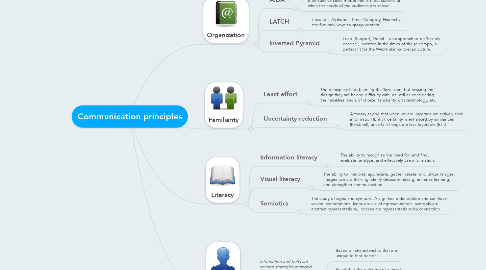
1. Organization
1.1. AIDA
1.1.1. Attention/Awareness, Interest, Desire, Action -- a persuasive sales model that is most successful when the needs of the audience are known.
1.2. LATCH
1.2.1. Location, Alphabet, Time, Category, Hierarchy -- the five only ways to group content.
1.3. Inverted Pyramid
1.3.1. Lead, Support, Detail -- an approach to be 'flexibly concise', invented in the times of the telegraph, a perfect fit for the Web's skim-and-scan culture.
2. Familiarity
2.1. Least effort
2.1.1. The principle of not blaming the 'lazy user', but revising the design they are having difficulty with, as well as considering their abilities, tools of choice, familiarity with technology, etc.
2.2. Uncertainty reduction
2.2.1. A theory saying that when we are uncertain we actively seek information (Entry); certainty is enhanced by similarities (Personal); uncertain things are less favorable (Exit).
3. Literacy
3.1. Information literacy
3.1.1. The ability to recognize the need for, and find, evaluate, analyze, and effectively use information.
3.2. Visual literacy
3.2.1. The ability to interpret, appreciate, gather, create, and utilize images. Images can aid thinking, clarify decision-making, enhance learning, and strengthen communication.
3.3. Semiotics
3.3.1. The study of signs and symbols. A sign has a denotation and can have several connotations. Icons are visual representations, symbols are abstract representations, indexes are representations by connection.
4. Tailoring
4.1. Information and behavior change strategies intended to reach one specific person
4.1.1. Based on characteristics that are unique to that person
4.1.2. Related to the outcome of interest
4.1.3. Segmentation, Evaluation, Selection
